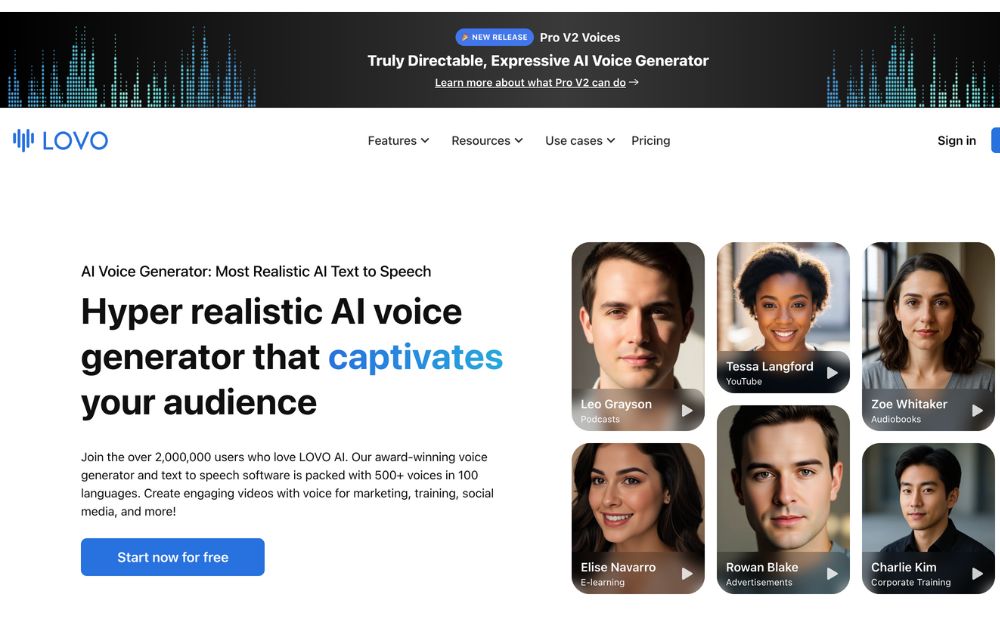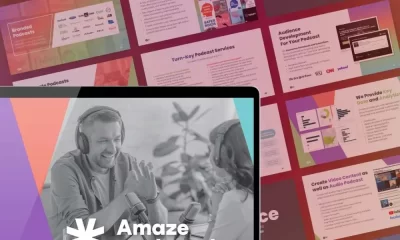Business
Interview: Max Temkin On Cards Against Humanity
Published
6 years agoon
By
Jie Kuang

During an exclusive interview with co founder Max Temkin, he tells us about business, Black Friday ideas, and doing things the Cards Against Humanity way. Best known for creating the game, he is also the cofounder of Blackbox, creator of Humans vs. Zombies, Secret Hitler, and Slap .45, and is on the National Finance Committee for Hillary for America. Though involved in politics, he does things a little differently, as you can see with America Votes with Cards Against Humanity. Like a true entrepreneur, the list of projects is endless. He describes himself as just a designer, but to think of him as just that would be foolish. Max Temkin is an inspiration for those aspiring to take their hobbies to the next level.
How did CAH get started?
Max Temkin – I’ve talked about this extensively in other interviews, but basically, the co-creators of Cards Against Humanity have a long history of making games together, and Cards Against Humanity was the first good one we play-tested. We put it out for free and it gained a cult following. Then we did a Kickstarter.
What are your backgrounds?
Max Temkin – I have a philosophy degree and I work on Democratic campaigns and elections. Some of the other Cards Against Humanity co-creators have backgrounds in economics, science, and advertising.
Why did you decide to create dick jokes instead of working in a different field?
Max Temkin – It was mostly a happy accident! We all still have outside interests, though Cards Against Humanity is my biggest project now.
When was your a-Ha moment?
Max Temkin – I’m not sure what that means! A time that sticks out in my memory that I knew Cards Against Humanity was pretty special was when I was play-testing it at college… I had a bunch of friends over in my dorm room, we were playing it and laughing, and more and more people kept coming over and joining. The laughter was contagious, and people kept coming in attracted by the spectacle. I saw that happen and I knew something special was going on.
How has sarcasm benefited your company?
Max Temkin – Not sure how to answer this one. We always try to find something earnest or authentic to make a joke about, and something that makes us laugh.
What is your on-boarding process?
Max Temkin – Is that like when you hire someone? We don’t have a lot of formal procedures. Trin is our events director and is kind of in charge of office morale, so she helps people find their place in the company.
Describe your office culture.
Max Temkin – We have a large open office that we built in Chicago, it’s a co-working space full of our friends… other designers, artists, musicians, podcasters, and weirdos from around the city.
What is the best way to respond to negative feedback?
Max Temkin – I try not to get defensive and rush to defend myself… I usually take a moment to absorb the criticism, and then translate it into something constructive that I can act on. Sometimes people have constructive criticism that I can’t act on, and I just try to make sure that they’re heard.
Who are some influencers that you admire?
Max Temkin – I truly hate thinking of people as “influencers,” thinking like that instrumentalizes all of the relationships in your life and makes them transactional. I don’t know that you can think about other people in terms of being an “influencer” or not, and still view them as honest and emotionally available to you.
What is the biggest lesson you learned since starting CAH?
Max Temkin – It’s been very hard for me to delegate and give work to other people… even when they’re way better than me. Our design director Amy Schwartz is a much better designer than me, the best designer I’ve ever worked with, and I really look up to her. I know that she outshines me in every skill. But it’s still emotionally so difficult to give up the work.
How do you determine a good employee at CAH?
Max Temkin – We look for kind, funny, and well-rounded people who are first good human beings and second good employees. We value a diversity of experience and viewpoint, and whether people have full, real lives outside of work.
What advice would you give to people trying to start their own business?
Max Temkin – Every good business that you admire figured things out for themselves. They forged their own path and came up with their own way of doing things. Apple does things the Apple way. McDonald’s does things the McDonald’s way. Cards Against Humanity does things the Cards Against Humanity way. Reading business advice and blindly following what other people did didn’t get those companies anywhere, and it won’t get you anywhere either. To make a successful company or brand, you need to start from first principles and figure out your own way forward.
What advice can you give people new to crowdfunding?
Max Temkin – Again the whole notion of “giving advice” on crowdfunding is kind of crazy to me. The whole point is to authentically figure out what you’re about and how to connect with other people. Some advice I like from Matthew Frederick’s 101 Things I Learned in Architecture School is that successful designers learn to make design decisions conditionally – that is, with the awareness that they may or may not work out as you continue toward a final solution.
Where do you see yourselves in 5 years?
Max Temkin – Tough question – I have no idea if people will still be playing Cards Against Humanity or care about us at all in five years. For the last five years, I’ve had a personal goal of making one small Kickstarter project a year. Sometimes they’re really small and personal like my Maxistentialism zine. And sometimes they’re huge public projects like my new game Secret Hitler. But I’d like to think that I’ll still be doing that in a year.
How did you come up with 12 Days of Holiday Bullshit?
Max Temkin – We needed to come up with some way to market Cards Against Humanity during the holidays that was funny and still had integrity. The first year we did a holiday stunt, it was a pay-what-you-want pack and we made $70,000, which we donated to charity. We felt like the next year we needed to out-do that. The blind subscription, where you pay us and get a series of mystery gifts in the mail, was a nice escalation. We did that for three years and now we’re taking a break.
How often do you guys visit Hawaii 2?
Max Temkin – I’ve never been! I hear from lots of people who have been to visit, and apparently it’s really nice during the summer.
What do you do with all the dumb ideas that people submit?
Max Temkin – Mostly we use them as kind of raw brainstorming ideas… I don’t think we’ve ever gotten a crowd suggestion that went directly into the game.
What are some Black Friday ideas that didn’t make the cut?
Max Temkin – We probably investigate a hundred ideas that don’t pan out to get to the one that works. The original idea was a $0.01-off coupon, but we ultimately rejected it because we felt that it was still a marketing deal. We always want to do something genuinely surprising and risky. This year’s is going to be a doozy.
How did you come up with the idea for The Bigger Blacker Box?
Max Temkin – People asked us for a big box that held all the cards, and over my strong objections, we decided to give them what they wanted. This was the best product we could design that fit those needs.
A few Redditors mentioned that they want to send you beer. Has this happened? Have you received anything out of the ordinary?
Max Temkin – We’ve gotten all kinds of crazy gifts and things from people. I love that people feel like they have a relationship with us and want to send us stuff, I think that’s a sign that we’re getting our message out there and our voice is coming through.
Jie writes about influencers and startups in various industries. She is a designer turned techie, and when she is not writing, you can find her in her workshop working on her next big project.

You may like

AI tools have evolved fast, and entrepreneurs now rely on them not just to automate tasks but to scale entire workflows. That said, it’s not surprising that many business owners are leveraging the power of cutting-edge technology. And this is where AI tools for entrepreneurs come in. Let’s look at what they are and a few examples you can check out.
1. Aomni Agent

Packed with powerful AI-driven features, Aomni Agent is a tool that can help you grow your company’s outbound pipeline by conducting research to give you new Ideal Customer Profiles (ICPs). With it, you no longer have to create account plans for each of your prospects, as the AI tool will do it for you.
Aomni Agent engages with your customers, provides support, automates routine tasks, and gives you real-time insights and analytics, among many other features. To know its pricing and additional information, you need to contact them directly through their website.
2. Pictory

A video creation tool, Pictory, can help you create engaging and professional videos in minutes. It uses AI that automatically generates videos from your text, images, and audio. This means you get excellent results even without any video editing skills.
You can use Pictory to generate videos from your blog posts, articles, and other text. It can also edit existing videos and add images, music, or text. It offers a free trial and three plans with subscription fees that range from $23 to $119 per month.
3. Zeda.io

Zeda.io has grown into a powerful AI-powered product operating system. With its 2.0 update, the platform now connects customer feedback, product strategy, roadmapping, and internal documentation into a single intelligent workspace.
Its AI engine analyzes thousands of customer inputs, from surveys to reviews to support tickets, to identify patterns, prioritize features, and suggest product improvements. What used to take days of manual synthesis now takes minutes. The updated version also includes AI-generated product briefs, automated roadmap updates, and integrations with popular tools like Slack, Notion, and HubSpot.
4. Slite Ask

Slite Ask is one of the most reliable AI knowledge-base assistants for teams. Instead of manually searching docs or old messages, entrepreneurs can simply “ask” a question and get an instant answer based on their workspace knowledge.
The AI scans company documents, policies, SOPs, and internal notes to deliver accurate responses without hallucinations. This makes onboarding smoother and speeds up decision-making, especially for remote or hybrid teams.
5. Credal.ai

Keep your data safe with an AI tool that’s perfect for entrepreneurs. Credal.ai is a software that provides a secure environment for AI applications to run and monitors them for any potential security threats. This helps you protect your business’s sensitive data from unauthorized users.
Credal.ai protects your data from leaks, malicious codes, and unauthorized access. It has a free plan but with limitations, so to get the most out of this AI tool, a Team or Enterprise plan is recommended. Pricing starts at $500 per month.
6. Webscraping.AI

Web scraping is the process of extracting data from a website, such as stock prices, product details, company contacts, and many more. If you want access to this information, you’ll need Webscraping.AI. It is easy to use and won’t require you to have any coding or technical skills. All you need to do is enter the website you want to scrape, and the tool will automatically get the data from the website.
Webscraping.AI can help business owners make better decisions by providing accurate data to identify new opportunities. It can also help them make better decisions for their strategies. Pricing for this AI tool for entrepreneurs ranges from $29 to $249 per month, with no hidden fees.
7. ValueProp.dev

A value proposition is a statement that tells your customers what your product or service is all about. This can be tricky, but worry no more, as ValueProp.dev is an AI tool for entrepreneurs created explicitly for this. It uses machine learning to analyze your customer data to generate unique value propositions for you.
ValueProp.dev can help you improve your business by generating value propositions that significantly increase customer acquisition, retention, and sales. It is free for up to three value propositions, but they also have premium plans for more options and features. Pricing starts at $29 per month.
8. Lovo.ai

A text-to-speech and text-to-video platform, Lovo.ai can help you create engaging and informative content for your content marketing strategies. It uses AI to generate realistic and human-loke voiceovers, videos, avatars, and others. You can extend your reach globally as this tool can do voiceovers and videos in more than 140 languages.
Lovo.ai can help you increase your engagement, improve your SEO rankings, and boost conversions. You can try their free plan to give you an idea of what the tool can do for you. But for more features, a paid plan that starts at $19 per month can provide more value.
9. Zigpoll

Zigpoll remains a solid choice for collecting customer insights, but its capabilities have expanded over the past two years. Today, Zigpoll uses AI to generate survey questions, summarize responses, detect sentiment, and even segment customers automatically.
Entrepreneurs can embed polls on websites, email campaigns, or post-purchase pages, then let Zigpoll’s AI categorize feedback into actionable insights. This helps brands quickly spot trends, product issues, or opportunities for upselling.
10. Pitches.ai

Are you looking to increase your business funding? Then creating the perfect pitch deck should be your priority. You can easily and quickly do this with Pitches.ai. It is an AI-powered tool for entrepreneurs to develop and refine pitch decks.
Pitches.ai analyzes pitch decks and gives you feedback on their structure, persuasiveness, and clarity. This gives you a higher probability of success. It offers four premium plans with prices ranging between $95 to $1,195.
Conclusion
Artificial intelligence is slowly becoming popular among business owners. Thanks to their many advantages, it’s no surprise that many will be using the technology from now on. These AI tools for entrepreneurs are a great example, and you should check them out today.
Featured Image Credit: Photo by Anna Shvets from Pexels
Business
What’s the Best Graphic Design Service for Education & eLearning?
Published
3 days agoon
November 13, 2025
TLDR: Best unlimited graphic design services for education and eLearning: ideal for quick turnaround, high-quality designs, and affordable pricing.
84% of communication is visual. Thus, for a world of education and eLearning, graphic design is imperative in the creation of projects for students and complex concepts. From interactive course materials to compelling marketing, strong visuals drive success. But finding a reliable, affordable design partner is tough.
Thus, it’s hard to come by a reputable service that can provide all your needs at a reasonable cost when it comes to project designs, turnaround expectations, anticipated quality and budgetary allowances.
But never fear! We’ve vetted what’s best for you!
1. Penji

If you’re looking for the best for education and eLearning purposes, Penji has the best overall value as quality, turnaround time and offers have placed it at a reasonable flat fee monthly.
Penji is an unlimited graphic design service that works as you would expect – unlimited – which means that for a flat fee monthly, you’ll have access to your very own team of designers.
Features:
- A Well-Qualified Team of Designers: Whether you need e-learning interactive designs to course visuals (infographics, presentations) Penji’s graphic designers make everything visually appealing to an academic audience.
- Turnaround: Average turnaround is about 24-48 hours so you can keep churning out material for course creation or marketing.
- Unlimited Revisions: As many times as needed to get your requested project right.
- Accessibility and Submission Portal: Penji comes with a site that’s fairly user-friendly for ease of access in submissions, critiques and conversations.
2. Kimp

If you need an unlimited source and don’t mind one that’s second best, Kimp boasts graphics and even video. Consider this option with caution – some reviews do mention turnover can vary and this wouldn’t be the best reliable option if you’re on a time crunch for every project.
Features:
- Wide Range of Services: Kimp provides both graphic design and video services, offering a versatile creative solution.
- Dedicated Designers: You’ll work with a group as your designated team so you get to know your specific creators.
- Easier Feedback Opportunities: Feedback can be given on the Kimp site for creations with visual access as to what you want changed.
3. Design Pickle

Design Pickle was one of the first unlimited graphic design services to go for an unlimited design game. This is helpful if you need custom illustrations or a presentation created for a polished look in any educated (or business) endeavor – higher tier subscriptions go with probability – but in all other worlds, it has more value than other sites when stacked against one another.
- Unlimited revisions to get the exact illustrations or graphics needed for presentations or other projects.
- Quick turnaround times to keep on schedule with 48 hour returns.
- Global Design Team: Boasts a diverse team of professional designers, offering expertise across multiple industries to match various client needs.
4. ManyPixels

ManyPixels is another reputable source that has unlimited graphic designs services but assignment transparency which means you’ll have one assigned designer to you, but they’re a bit more transparent with regards to who may (or not) be able to help you but will get back to you with good timing.
- One Dedicated Designer: ManyPixels is a company that does not have unlimited designs, however you’ll have one assigned who will know your needs better than most.
- Good Turnaround Time: Generally they’ll turn around assignments within 1-2 days after submission regardless of simplicity/complexity.
- Reliable Designs: Good for marketing or simple visuals/templates you’d want to use for educational continuity but they may not give as specialized feedback as you’d think.
Cover Image Credit: Photo by Fox on Pexels
Business
What are the Best Graphic Design Services for Fashion Brands?
Published
4 days agoon
November 11, 2025
For many businesses, graphic design means conversions, credibility, and brand recall. So, if you’re in the fashion industry, you also need to have significant visual assets if growth is your priority. If you need help finding the best graphic design service for your fashion brand, we made a list of the top five:
Penji

An on-demand graphic design platform, Penji offers unlimited graphic design services for fixed monthly fees. This allows you to send as many requests for lookbooks, catalogs, packaging designs, and many other marketing materials for less. Its team of top-notch designers assures you of consistent and high-quality work worthy of your fashion business.
Kimp

Built to support the creative needs of many businesses, including fashion, Kimp is another platform that offers unlimited design requests. It can craft product mockups, campaign visuals, packaging designs, and social media graphics, among others. It also provides video editing services, making it ideal for fashion companies that run reels, seasonal promos, or behind-the-scenes edits.
Designity

Combining agency-level creative direction with flexible access to US designers, Designity suits fashion brands that need polish, strategy, and scalability. They can provide you with social media graphics, online ads, label designs, logo and branding, and magazine layouts, among other key services.
Flocksy

If your business needs video editing, copywriting, and voice-over services, then Flocksy is the best graphic design service for your fashion brand. In addition, it also offers custom illustrations, packaging design, infographics, and many other design services. It operates on a flat-rate pricing model, making it a more cost-effective option than hiring freelancers or working with expensive agencies.
Reel Unlimited

With its predictable pricing and wide array of graphic design services, Reel Unlimited is an excellent design solution for fashion brands. Like many on this list, it offers unlimited design requests and fast turnaround times, making it the ideal option for those with tight schedules and limited budgets.

What’s the Best Graphic Design Service for Beauty & Wellness Brands

10 Best AI Tools for Entrepreneurs

Our Top 10 Video Editing Tools for Smarter Content Production

What’s the Best Graphic Design Service for Education & eLearning?

What are the Best Graphic Design Services for Fashion Brands?

How TikTok and Instagram Track You Using In-App Browsers

What’s the Best Graphic Design Service for Marketing Agencies?

Top 10 Tablets to Use in 2025

Our Top 10 Video Editing Tools for Smarter Content Production

How TikTok and Instagram Track You Using In-App Browsers

Top 10 Free and Paid Employee Communication Tools

10 Best AI Tools for Entrepreneurs

10 Best Photo Editing Apps for Personal and Business Use in 2026

What’s the Best Graphic Design Service for Healthcare Brands?
Trending
- Technology2 days ago
Our Top 10 Video Editing Tools for Smarter Content Production
- Technology4 days ago
How TikTok and Instagram Track You Using In-App Browsers
- Business2 days ago
10 Best AI Tools for Entrepreneurs
- Business4 days ago
What are the Best Graphic Design Services for Fashion Brands?
- Uncategorized5 days ago
What’s the Best Graphic Design Service for Marketing Agencies?
- Business3 days ago
What’s the Best Graphic Design Service for Education & eLearning?
- Uncategorized2 days ago
What’s the Best Graphic Design Service for Beauty & Wellness Brands




















